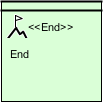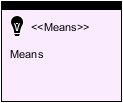How to Draw Business Motivation Model (BMM) Diagram?
A Business Motivation Model provides business enterprises a set of notations for forming business plans. It models what the enterprise wishes to achieve, how to achieve, potential impacts, resources and etc.
 |
| A sample Business Motivation Model diagram |
Creating Business Motivation Model (BMM) diagram
- Select Diagram > New from the application toolbar.
- In the New Diagram window, select Business Motivation Model Diagram.
- Click Next.
- Enter the diagram name and description. The Location field enables you to select a model to store the diagram.
- Click OK.
Notations
The description of notations is taken from OMG BMM Specification v1.1.
|
||||||||||||||||||||||||||||||||||||||||||||||||||||||||||||||||||||||||||||||||||||||||||||||||
| A list of supported notations in Business Motivation Model (BMM) diagram |
| Chapter 2. Business Motivation Model diagram | Table of Contents | Part XXV. Appendix A - Application Options |

















